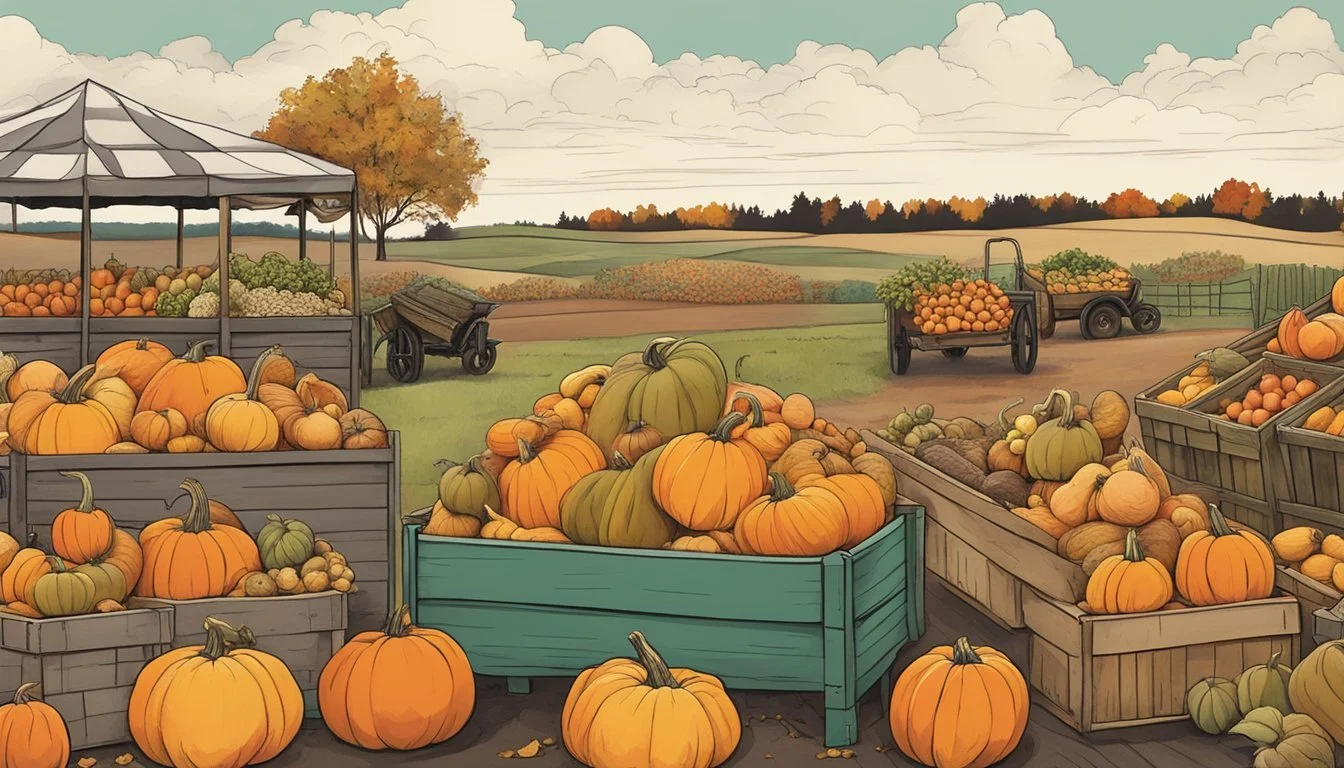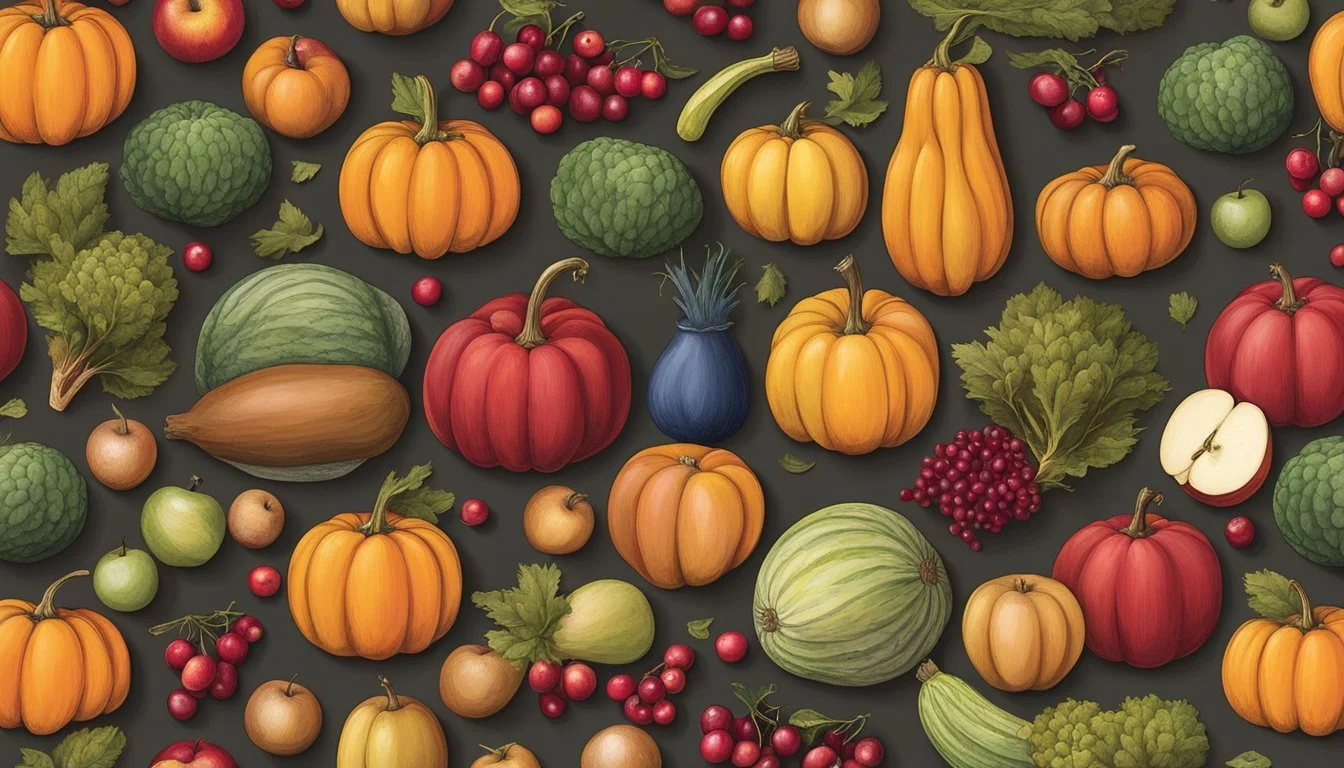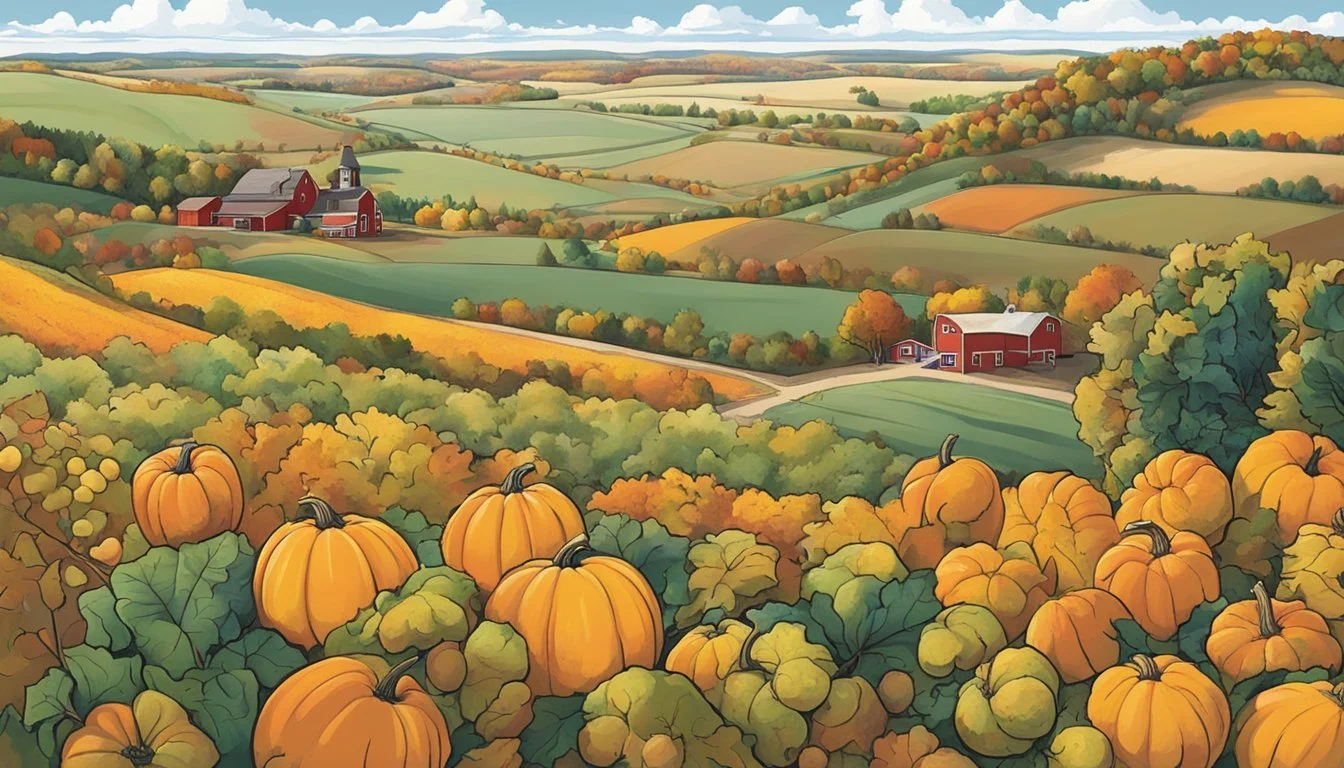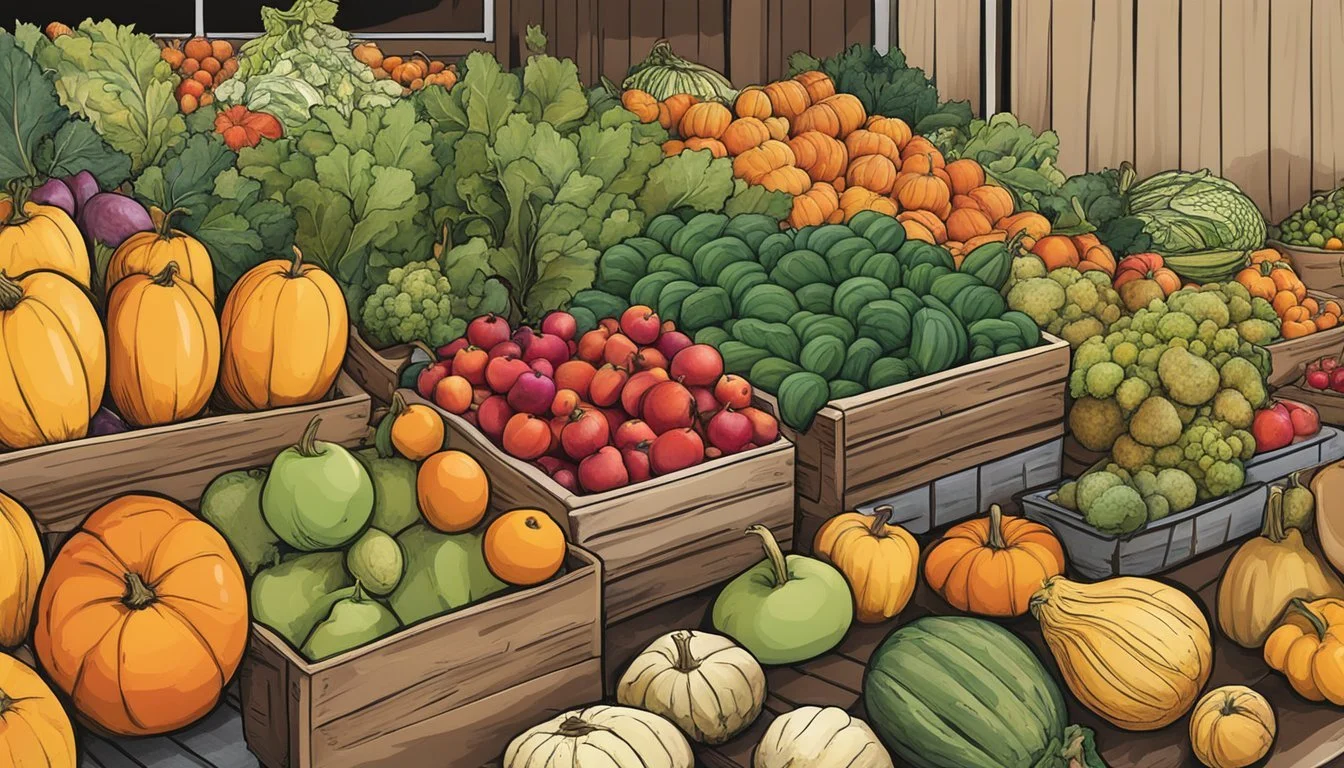South Dakota Seasonal Fruit & Vegetables in November
A Guide to Fresh Produce
This Article is Part of our South Dakota Seasonal Fruit & Veg Calendar
As the brisk winds of November sweep across South Dakota, the state's agricultural focus shifts to the hardy produce that thrives in its unique climate. November marks a transitional period when summer's bounty has dwindished and farmers prepare for the colder months. In this time, residents and chefs alike turn to robust vegetables and stored harvests to inspire their seasonal menus.
South Dakota's climate, characterized by cold winters and hot summers, presents a challenge for growers, but also yields an assortment of produce that can withstand the early frosts. Root vegetables such as carrots (how long do carrots last?) and potatoes, along with various squashes, are common sights in the local markets. These staples, harvested prior to the first frost, often continue to be available through careful storage techniques.
Though fruit selections may be more limited during this time, apples (how long do apples last?) remain a quintessential November pick thanks to their late ripening and storage capacity. While the harvest season for many fruits has passed, the hardier varieties that have been picked in late autumn can still be found fresh in the state. The focus in South Dakota during this month is largely on the vegetables that can endure the chill, ensuring that despite the dropping temperatures, the availability of seasonal produce persists.
Understanding South Dakota's Climate
South Dakota's climate is characterized by four distinct seasons, with variations in temperature and precipitation patterns that are essential for agricultural planning. The state lies within USDA Hardiness Zones 3 through 5, which influences the growing seasons and types of crops that can be successfully cultivated.
Winter in South Dakota often means extremely cold temperatures, with rapid drops sometimes reaching well below zero degrees Fahrenheit. These conditions make it challenging for most crops, although some winter-hardy vegetables can survive.
During fall, the climate begins to transition with cooler temperatures. This season is important for the harvest period of many crops that thrive in the gentler conditions after extreme heat and potential drought in summer.
The state's climate can also shift to extreme conditions, experiencing occasional summer heat waves that exceed 100 degrees Fahrenheit. Such heat can stress plants unless they are drought-resistant or well-irrigated.
South Dakota generally experiences low humidity, which can mitigate some effects of heat but also contributes to drought conditions. Precipitation varies across the state, with some regions receiving more rainfall than others, influencing water availability for crops.
List of Typical Climatic Conditions in South Dakota:
Winter: Severe cold, potential heavy snowfall
Fall: Cooler temperatures, end of the growing season
Hardiness Zones: 3-5, affecting plant survival and growth
Climate: Semi-arid, with significant temperature swings
Extreme Heat: Summer temperatures can exceed 100°F
Drought: Occurs periodically, affects water availability
Farmers and gardeners in South Dakota must therefore plan their agricultural activities closely aligned with this climate pattern to ensure successful crop yields.
Seasonal Food Guide for November
November in South Dakota marks a transition into the cooler months, where a variety of produce reaches its optimal harvest. Individuals looking to incorporate seasonal fruits and vegetables into their meals have an array of choices.
Fruits: While November isn't the peak season for a wide range of fruits, consumers can still enjoy certain varieties that store well from earlier harvests. Apples, which are harvested in late summer and fall, continue to be crisp and flavorful.
Vegetables: Vegetable selections boast a robust variety with an emphasis on winter squash and root vegetables. These hearty items not only provide sustenance but also offer a comfort aspect to meals during the colder days.
Winter Squash: Varieties such as butternut, acorn, and spaghetti squash are abundant. They are versatile in the kitchen, suitable for baking, roasting, and pureeing.
Root Vegetables: November is an ideal time for root vegetables. Carrots, turnips, and beets (how long do beets last?) are perfect for roasting or adding to stews.
Greens: Hardy greens such as kale (What wine goes well with kale?) and spinach can still be found. These greens are nutritious and can withstand the colder temperatures.
Here's a simplified list of what consumers might find:
Fruits Vegetables Apples Winter Squash Carrots Turnips Beets Kale Spinach
This guide offers insight into the November landscape of South Dakota's produce, ensuring that consumers and chefs alike can plan their menus with seasonal awareness. Embracing these selections not only supports local agriculture but also provides peak freshness and nutrition.
Highlighting November's Seasonal Vegetables
In November, South Dakota's local produce offerings shift towards hearty vegetables that withstand the cooler temperatures. These nutrient-rich selections provide the foundation for seasonal dishes.
Crucial Root Vegetables
Root vegetables thrive in South Dakota's November climate, offering a rich source of vitamins and minerals. Carrots and beets are particularly versatile, perfect for roasting or adding to hearty stews. Sweet potatoes serve as another staple, with their natural sweetness and robust flavor profile. These vegetables can also be stored well, making them a practical choice for winter supplies.
Carrots: High in beta-carotene, perfect for soups and side dishes.
Sweet Potatoes: A sweeter root option, ideal for baking and mashing.
Beets: Deeply colored, they add vibrancy and nutrients to any meal.
Turnips: Offer a slightly peppery taste, suitable for mashing and roasting.
Popular Greens and Squashes
South Dakota residents also rely on nutrient-dense greens such as kale and spinach, which can survive the dropping temperatures. Their resilience makes them a fantastic, fresh addition to the table even as winter approaches. Meanwhile, winter squash and pumpkins come into their own, providing a comforting texture and flavor that's synonymous with the season. These squashes are not only delicious but also packed with fiber and vitamin A.
Kale: Hardy and nutritious, can be used in salads or sautéed as a side.
Spinach: Tender yet resilient, great for salads or a quick wilted dish.
Winter Squash: Includes varieties like acorn and butternut, excellent for soups and purées.
Pumpkins: Beyond decoration, they are great for pies, soups, and roasting.
Highlighting November's Seasonal Fruits
November, while inching towards winter, offers a selection of hearty fruits that can withstand the cooler climates. Consumers can reap the benefits of this month's bounty in South Dakota, as farmers markets and stores stock up on fruits that are particularly robust during this season.
In South Dakota, apples remain a standout fruit in November. They come in a variety of types, some of which reach peak ripeness in the autumn months. Apples are versatile fruits, suitable for fresh eating, baking, and for making cider or applesauce.
Pears share the spotlight, offering their sweet, buttery flesh to the November fruit selection. Like apples, they can be enjoyed fresh, cooked, or even preserved. Their storage and handling flexibility make them a fall favorite.
Though not as commonly found, cranberries also mark their seasonal appearance. Traditionally associated with Thanksgiving meals, they are used in sauces, juices, and baked goods. These tart berries are loaded with antioxidants and provide vibrant color to the seasonal palette.
Lastly, persimmons may make an unexpected yet welcome appearance. Two primary types, the Fuyu and Hachiya, are enjoyed for their unique flavors once they've fully ripened to a soft and sweet state. Persimmons can be eaten fresh, dried, or used in recipes like puddings and breads.
Fruit Uses Flavor Apples Fresh, baking, cider, preserves Sweet to tart Pears Fresh, cooked, preserves Sweet, buttery Cranberries Sauces, juices, baked goods Tart Persimmons Fresh, dried, desserts Sweet when ripened
The fruits mentioned are just a few highlights of what November brings to South Dakota. Each offers its own unique flavor profile and cooking versatility, fitting well into the seasonal transition.
The Harvesting Process
In South Dakota, the month of November brings the close of the harvest season, with specific timing and techniques crucial for ensuring the quality of produce. Farmers must contend with various challenges, including pests and unpredictable weather.
Timing and Techniques
The timing of the harvest is critical and depends on the specific type of fruit or vegetable. In November, one may still find late-season crops such as pumpkins, winter squash, and root vegetables. Harvest times are usually determined by monitoring the maturity of the crop to ensure peak flavor and storage longevity.
Harvesting techniques vary. Delicate fruits like raspberries must be handpicked, while root vegetables may be harvested using mechanized equipment to ensure efficiency and limit damage. In late autumn, producers also shift focus to proper storage to extend the availability of their products beyond the harvest season.
Challenges During Harvest
Farmers face several challenges during the harvest:
Pests: Late-season fruits and vegetables may attract deer, rabbits, and squirrels, necessitating measures to protect the crops, such as fencing or netting.
Insects and Disease: Vigilance is key as cooler weather can lead to a surge in certain insect populations and diseases that thrive in these conditions, impacting both yield and quality.
Weather Fluctuations: Sudden frosts or unseasonably warm spells can adversely affect harvest results. Farmers must closely monitor weather reports and employ protective measures such as row covers when necessary.
Throughout the harvesting process, the goal is to secure the best possible produce while minimizing losses to pests, weather, and other challenges that could compromise the season’s efforts.
Health Benefits of Seasonal Produce
Eating seasonal produce ensures consumers receive the highest nutritional content and experience the rich flavors that nature intended. Freshness is key for nutrient retention and taste satisfaction.
Nutritional Value
Seasonal fruits and vegetables harvested during their appropriate months are typically richer in vitamins and minerals. For instance, iron, an essential nutrient found in leafy greens, is more abundant in these vegetables when they are in season. Seasonal produce such as autumn squash and apples contain antioxidants that the body needs to function optimally.
Iron: Found in higher concentrations in seasonal leafy greens.
Antioxidants: Abundant in seasonal fruits like apples.
Advantages Over Non-Seasonal Foods
Consuming seasonal produce over non-seasonal foods offers several benefits:
Enhanced Flavor: Seasonal produce is often fresher and hence, has a superior taste. Fresh fruit like South Dakota November apples are renowned for their crispness and juiciness.
Health: When produce is picked and consumed at its peak ripeness, the nutritional benefits are also at their highest. This means more vitamins and essential nutrients per serving.
Non-Seasonal Seasonal Less flavorful More intense flavor Potential nutrient loss due to transport Higher nutrient levels Often picked before ripening Harvested at peak ripeness
By focusing on seasonal fruits and vegetables, individuals may enjoy more delicious meals while optimizing their health through natural means.
South Dakota's Seasonal Food Availability
In November, consumers in South Dakota have access to a range of seasonal fruits and vegetables. Local markets and farms typically offer produce that can withstand the cooler temperatures, providing residents with fresh, locally-grown options.
Monthly Availability Chart
Vegetables Fruits Availability Kale Apples High Pumpkins Pears Medium Brussel Sprouts Medium Winter Squash High Potatoes High
Note: This chart reflects general availability and may vary by location.
Local Market Guide
South Dakota's markets in November highlight local produce availability. Shoppers should look for state-supported agricultural programs that feature vegetables in season such as kale and brussel sprouts. While fruit options are limited, apples and pears are typically available and sourced from regional orchards. Consumers are encouraged to visit various markets to explore the diversity of available produce. The local market scene is robust, often providing a map to guide consumers to the freshest options.
Consumer Tips and Advice
When shopping for seasonal fruits and vegetables in South Dakota during November, consumers should prioritize freshness and proper storage to maximize shelf life and flavor. Knowing how to select the best produce and preparing it can elevate one's cooking, providing delicious and nutritious meals.
Selecting and Storing Tips
Apples: They should be firm to the touch and have a vibrant color. Storage is best in a cool, dark place or refrigerated; they can stay fresh for 3 to 4 weeks.
Root Vegetables (such as carrots and beets): Look for smooth, firm roots. Store them in a cool, dry place; they can be kept for 2 to 3 weeks.
Winter Squash: Choose squash that feels heavy for its size and has hard, thick skin. Store in a cool, dry place away from direct sunlight, and it should last up to a month.
Simple guide to storage:
Produce How to Select Storage Tips Apples Firm, vibrant color Cool, dark place or refrigerated Root Vegetables Smooth, firm Cool, dry place Winter Squash Heavy for size, hard thick skin Cool, dry place, away from sunlight
Preparing Seasonal Dishes
When cooking with November’s harvest, using fresh ingredients and appropriate recipes will bring out the best in what the season has to offer.
Apples: Ideal for both sweet and savory dishes. They can be baked, roasted, or stewed.
Root Vegetables: Roasting these vegetables can enhance their natural sweetness. They're also perfect for hearty stews.
Winter Squash: Can be roasted, mashed, or used in soups. Their rich texture complements spices well, making them suitable for a variety of dishes.
Collections of recipes:
Apples: Apple pies, apple crisps, apple chutney.
Root Vegetables: Roasted root vegetable medley, carrot soup, beet salad.
Winter Squash: Butternut squash soup, stuffed acorn squash, spaghetti squash pasta.









